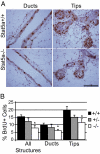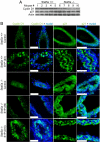Signal transducer and activator of transcription 5a mediates mammary ductal branching and proliferation in the nulliparous mouse
- PMID: 20392833
- PMCID: PMC2875824
- DOI: 10.1210/en.2009-1282
Signal transducer and activator of transcription 5a mediates mammary ductal branching and proliferation in the nulliparous mouse
Abstract
Signal transducer and activator of transcription (Stat)5a is a critical regulator of mammary gland development. Previous studies have focused on Stat5a's role in the late pregnant and lactating gland, and although active Stat5a is detectable in mammary epithelial cells in virgin mice, little is known about its role during early mammary gland development. In this report, we compare mammary gland morphology in pubertal and adult nulliparous wild-type and Stat5a-/- mice. The Stat5a-null mammary glands exhibited defects in secondary and side branching, providing evidence that Stat5a regulates these processes. In addition, Stat5a-/- mammary glands displayed an attenuated proliferative response to pregnancy levels of estrogen plus progesterone (E+P), suggesting that it plays an important role in early pregnancy. Finally, we examined one potential mediator of Stat5a's effects, receptor activator of nuclear factor-kappaB ligand (RANKL). Stat5a-/- mammary glands were defective in inducing RANKL in response to E+P treatment. In addition, regulation of several reported RANKL targets, including inhibitor of DNA binding 2 (Id2), cyclin D1, and the cyclin-dependent kinase inhibitor p21(Waf1/Cip1), was altered in Stat5a-/- mammary cells, suggesting that one or more of these proteins mediate the effects of Stat5a in E+P-treated mammary epithelial cells.
Figures





Similar articles
-
Progesterone receptor and Stat5 signaling cross talk through RANKL in mammary epithelial cells.Mol Endocrinol. 2013 Nov;27(11):1808-24. doi: 10.1210/me.2013-1077. Epub 2013 Sep 6. Mol Endocrinol. 2013. PMID: 24014651 Free PMC article.
-
Signal transducer and activator of transcription 5 as a key signaling pathway in normal mammary gland developmental biology and breast cancer.Breast Cancer Res. 2011 Oct 12;13(5):220. doi: 10.1186/bcr2921. Breast Cancer Res. 2011. PMID: 22018398 Free PMC article. Review.
-
Estrogen and progesterone are critical regulators of Stat5a expression in the mouse mammary gland.Endocrinology. 2008 Jan;149(1):329-38. doi: 10.1210/en.2007-0594. Epub 2007 Sep 20. Endocrinology. 2008. PMID: 17884938 Free PMC article.
-
PIKE-A is required for prolactin-mediated STAT5a activation in mammary gland development.EMBO J. 2010 Mar 3;29(5):956-68. doi: 10.1038/emboj.2009.406. Epub 2010 Jan 14. EMBO J. 2010. PMID: 20075866 Free PMC article.
-
The biology of progesterone receptor in the normal mammary gland and in breast cancer.Mol Cell Endocrinol. 2012 Jun 24;357(1-2):4-17. doi: 10.1016/j.mce.2011.10.030. Epub 2011 Dec 13. Mol Cell Endocrinol. 2012. PMID: 22193050 Free PMC article. Review.
Cited by
-
Hormone-sensing cells require Wip1 for paracrine stimulation in normal and premalignant mammary epithelium.Breast Cancer Res. 2013 Jan 31;15(1):R10. doi: 10.1186/bcr3381. Breast Cancer Res. 2013. PMID: 23369183 Free PMC article.
-
Progesterone receptor and Stat5 signaling cross talk through RANKL in mammary epithelial cells.Mol Endocrinol. 2013 Nov;27(11):1808-24. doi: 10.1210/me.2013-1077. Epub 2013 Sep 6. Mol Endocrinol. 2013. PMID: 24014651 Free PMC article.
-
Hormone-sensing mammary epithelial progenitors: emerging identity and hormonal regulation.J Mammary Gland Biol Neoplasia. 2015 Jun;20(1-2):75-91. doi: 10.1007/s10911-015-9344-1. Epub 2015 Sep 21. J Mammary Gland Biol Neoplasia. 2015. PMID: 26390871 Review.
-
Toward Characterizing Lymphatic Vasculature in the Mammary Gland During Normal Development and Tumor-Associated Remodeling.J Mammary Gland Biol Neoplasia. 2024 Jan 13;29(1):1. doi: 10.1007/s10911-023-09554-w. J Mammary Gland Biol Neoplasia. 2024. PMID: 38218743 Free PMC article. Review.
-
Signal transducer and activator of transcription 5 as a key signaling pathway in normal mammary gland developmental biology and breast cancer.Breast Cancer Res. 2011 Oct 12;13(5):220. doi: 10.1186/bcr2921. Breast Cancer Res. 2011. PMID: 22018398 Free PMC article. Review.
References
-
- Howlin J, McBryan J, Martin F 2006 Pubertal mammary gland development: insights from mouse models. J Mammary Gland Biol Neoplasia 11:283–297 - PubMed
-
- Brisken C, Rajaram RD 2006 Alveolar and lactogenic differentiation. J Mammary Gland Biol Neoplasia 11:239–248 - PubMed
-
- Darnell Jr JE 1997 STATs and gene regulation. Science 277:1630–1635 - PubMed
-
- Ihle JN 1996 STATs: signal transducers and activators of transcription. Cell 84:331–334 - PubMed
Publication types
MeSH terms
Substances
Grants and funding
LinkOut - more resources
Full Text Sources
Research Materials
Miscellaneous

